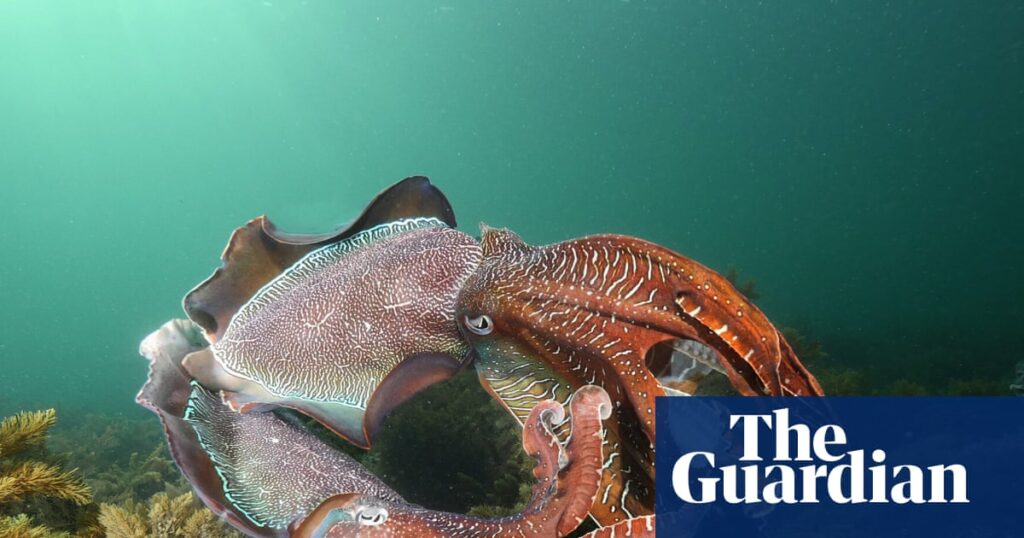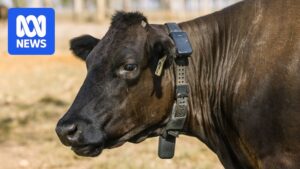
A safety curtain of air bubbles has been installed in South Australia’s Spencer Gulf in an urgent effort to protect giant cuttlefish from a potentially catastrophic “near-extinction event” due to a deadly algal bloom. This intervention aims to safeguard the unique annual breeding aggregation of giant Australian cuttlefish off the coast of Whyalla.
Each year, tens of thousands of these marine creatures gather in a globally unique natural phenomenon. However, this year, the presence of a toxic algal bloom creeping northwards towards their breeding site at Point Lowly has raised significant concerns among scientists. With hatchlings expected to emerge in late spring, the risk to the cuttlefish population is unprecedented.
The Bubble Curtain Initiative
An experimental “bubble curtain” measuring 200 meters by 100 meters has been deployed, funded by both state and federal governments. This technology, which utilizes land-based generators and compressors to pump air through underwater feeder lines and tubing, creates bubbles designed to disrupt the movement of algae and form a protective buffer zone along the rocky reef.
While the bubble curtain has been successfully trialed in Western Australia to protect kelp from fish, this is its first application in South Australia and at such a scale. The initiative aims to protect approximately 50,000 to 80,000 cuttlefish eggs and hatchlings from the advancing bloom.
Expert Insights and Concerns
Dr. Zoe Doubleday, a cuttlefish and octopus expert at the University of South Australia, emphasizes the uniqueness of the giant Australian cuttlefish aggregation, which occurs annually from late May to August. “It’s the only population of giant Australian cuttlefish—and the only population of cuttlefish worldwide—that comes together and breeds in their tens of thousands, forming this spectacular natural wonder,” she stated.
“It’s in situ, so … they only need to switch it on if the algae starts approaching,” said Dr. Doubleday, describing the curtain as a “worst-case scenario measure.”
After spawning, adult giant cuttlefish typically die, leaving the next generation entirely reliant on the success of their eggs. “Because mum and dad die, these eggs are essentially it,” Doubleday explained. “If the bloom does reach them—and they take three to five months to incubate and hatch—they could have potentially a near-extinction event.”
Professor Gretta Pecl from the University of Tasmania’s Institute for Marine and Antarctic Studies highlights the importance of the Spencer Gulf trial. “This technique’s effectiveness is crucial in a future where more blooms are possible,” she noted.
Current Conditions and Government Response
The latest update on the state’s harmful algal bloom, released on Wednesday, showed that marine heatwave conditions, a contributing factor, had subsided along the coast and in shallower waters. However, satellite images revealed elevated and increasing levels of chlorophyll, an indicator of algae concentrations, along the western coastline of the Spencer Gulf up to Murninnie Beach—approximately 90km from the Cuttlefish Coast Sanctuary Zone.
The latest giant cuttlefish counts estimated the population at about 63,400 this season, compared with 81,420 in 2024.
State Premier Peter Malinauskas affirmed the government’s commitment to protecting the species, taking guidance from its scientific advisory panel. “The giant Australian cuttlefish is an iconic and spectacular creature,” he said. “The state government is doing everything it can to ensure this precious population survives the algal bloom.”
Looking Ahead
The deployment of the bubble curtain represents a significant step in marine conservation efforts, particularly as environmental challenges become more frequent and severe. As the trial progresses, scientists and policymakers will closely monitor its effectiveness, potentially setting a precedent for similar interventions in other vulnerable marine ecosystems.
As the situation unfolds, the scientific community remains vigilant, ready to adapt strategies to ensure the survival of these remarkable creatures. The outcome of this initiative could provide valuable insights into managing future ecological threats, not only in South Australia but globally.






